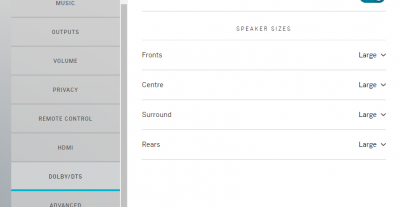Difference between revisions of "Template:;Manage System:Dolby/DTS"
m |
m (→Speaker size (Large/Small)) |
||
| Line 12: | Line 12: | ||
:To define the <b><u>Surround playback</u></b> loudspeaker size. | :To define the <b><u>Surround playback</u></b> loudspeaker size. | ||
| − | ::<b>Large:</b> | + | ::<b>Large:</b> |
| − | ::<b>Small:</b> | + | ::<b>Small:</b> |
<br><br><br><br> | <br><br><br><br> | ||
Revision as of 10:13, 24 August 2021
Decode Mode
- Off - No up-mixing performed
- Auto - PCM streams up-mixed using DTS Neo 6 Auto algorithm
- DTS Neo 6 Music - PCM streams up-mixed using DTS Neo 6 Music algorithm
- DTS Neo 6 Video - PCM streams up-mixed using DTS Neo 6 Movie algorithm
The Decode Mode setting is applicable to audio received by the following sources:
- HDMI, HDMI ARC, HDMI eARC, SPDIF and Toslink
Streaming sources (radio, Qobuz, etc.) and analogue inputs cannot be up-mixed. These will always be presented in stereo.
For all modes above downmixing if required will then be performed based on the number of speakers in the system.
Dynamic range compression
- Standard
-
- This mode has the widest dynamic range (the difference between the quietest and loudest sounds).
- Quiet remains quiet, loud remains LOUD (i.e. explosions will "blow your socks off!")
- Medium
-
- This mode has a medium difference dynamic range.
- Making quiet sounds louder and louder sounds quieter (not as big a difference in sound volume)
- Maximum
-
- This is maximum compression
- Making quiet sounds louder and louder sounds quieter (not as big a difference in sound volume and "keeps your socks on")
Speaker size (Large/Small)
- To define the Surround playback loudspeaker size.
- Large:
- Small:
